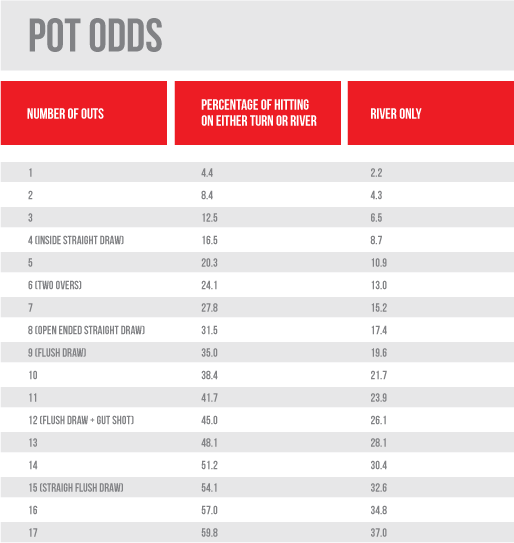How can tell whether it is profitable for us to call with a draw in any particular spot? It is possible to do so using odds and outs. But what do we mean by “odds and outs”?
Outs
An “out” in poker is any card which will improve your hand to one that will likely be better than your opponents.
So if we were to have 56on a 47a flop, any 8 or 3 would be “outs” to make a straight. We would have a total of 8 outs, because there are four 8s in the deck and four 3s.
Out - "Any card that will improve your hand making it better than your opponent's"
Once we have calculated the amount of outs we have, we can use this to calculate our “equity”. “Equity” describes the percentage chance of us having the best hand by the time we get to showdown.
Equity describes the percentage chance of us having the best hand by the time we get to showdown
Calculating Equity
Here's a chart to help you calculate your odds of hitting with a particular draw after the flop comes down:

In order to calculate our equity we will are going to multiply our number of outs either by 2, or by 4. If we are on the flop we will multiply by 4, if we are on the turn we will multiply by 2.
Estimating Equity
Equity = (# of outs) * 4 (on the flop)
(# of outs) * 2 (on the turn)
In the example where we have the 56 on the 47a we have 8 outs, so our equity is roughly:
8 * 4 = 32% equity
If we had this same hand on 47a & k turn, we’d now have:
8 * 2 = 16% equity
Good Outs, Tainted Outs
“Good” outs are simply outs that definitely make you the best hand. In the above example it is clear to see which cards are “good” outs because you make the nuts. In other cases you can’t be so certain.
Example:
you hold a8 on a q108 flop.
It’s pretty obvious that any heart will be a good out for you because you will make the nuts. But what about an Ace or an Eight? It’s certainly possible these outs will be good –but you can’t be certain. Your opponent may hold a hand like aq, jk, 1010, or 9j, in which case an Ace is never a good out, and an Eight is only good sometimes.
“Tainted” outs are “bad” outs, but usually describe an out that is bad because it improves (or might improve) your opponent’s hand at the same time it improves yours. The Ace out in the above hand could be considered “tainted” because your opponent could hold KJ. When you improve to 2pair he improves to a straight.
Tainted out - An out that possibly won't give you the best hand if you hit, because it might improve your opponent's hand also
To consider another example:
you have 57 on a q10a & 4 turn.
You have a flush draw but any of your spade outs could easily be tainted if your opponent holds a higher flush draw. Even if your opponent doesn’t have a flush draw the As or the 4s may be tainted if it improves your opponent’s 2-pair or 3-of-a-kind, making a full-house.
Discount your outs
In order to compensate for the fact that sometimes our outs may be tainted/bad, we simply count fewer outs when calculating our equity. To take the a8 on a q108 flop – if ALL of our possible outs were always good we’d have a total of:
9 * Heart outs +
3 * Ace outs +
2 * Eight outs +
--------------------------------
14 outs
There is a decent chance our Ace out might not be good though. Perhaps we estimate that our Ace out is only going to be good 33% of the time and our Eight out only 50% of the time.
Our estimated number of outs becomes:
9 * h outs +
1 * Ace outs +
1 * Eight outs +
--------------------------------
11 outs
If we wanted to be even more conservative we could not count our Ace or Eight outs at all.
(In a similar way - if you are on the flop but think it’s unlikely you will see a free river card, you should multiply your outs by 2 instead of 4 to find your equity. If you estimate you will see a river card 50% of the time you could choose to multiply by 3 etc.)
Pot-Odds
Gamblers are usually familiar with the concept of odds. Odds describe how much of a return we will see on our wager if we win. Usually the odds will give a rough indication of how likely that event is to happen. This is no accident – the bookmakers have chosen these odds specifically. It ensures they make a profit from their customers. Successful poker players do a very similar thing.
are usually familiar with the concept of odds. Odds describe how much of a return we will see on our wager if we win. Usually the odds will give a rough indication of how likely that event is to happen. This is no accident – the bookmakers have chosen these odds specifically. It ensures they make a profit from their customers. Successful poker players do a very similar thing.
Odds are measured using “ratios”. A ratio is a mathematical term – here is a simplified definition:
Ratio - "The relationship between 2 numbers, indicating how often the first appears in the second- expressed in the format (number1: number2)"
The two numbers we are interested in are:
- The amount that is already in the pot (The amount we can potentially win)
- The amount we need to call (The amount we wager)
Eg: There is $10 in the pot, and our opponent bets $10. What pot-odds are we getting?
Firstly, how much is in the pot? There is the $10 already in the middle plus the $10 our opponent is betting. The total is $20.
How much does it cost us to call? $10.
We are getting pot odds of $20:$10. We can simply this if we divide by the biggest number which fits into both also known as “the highest common factor”. In this case, if we divide both sides of the ratio by $10, we end up with 2:1 odds.
Should you Make the Call?
No, we aren’t talking about the guy/girl you met at the club last night. We want to know mathematically when it is ok to call with your drawing hand.
If all has gone to plan, you should have two pieces of information at this stage.
- Your estimated equity
- Your pot odds expressed as a ratio


